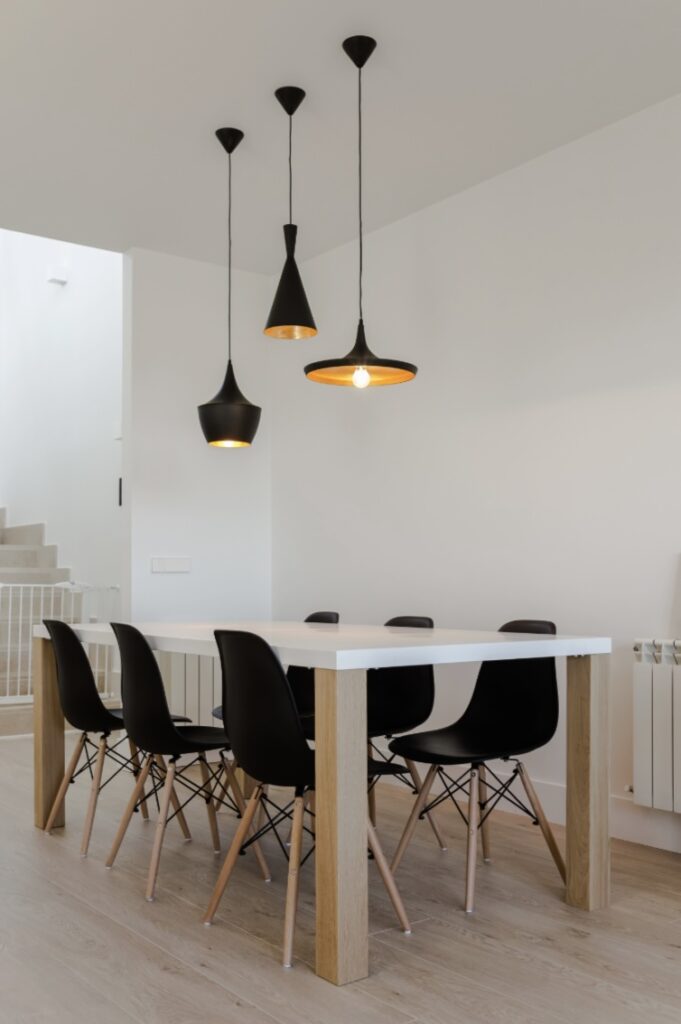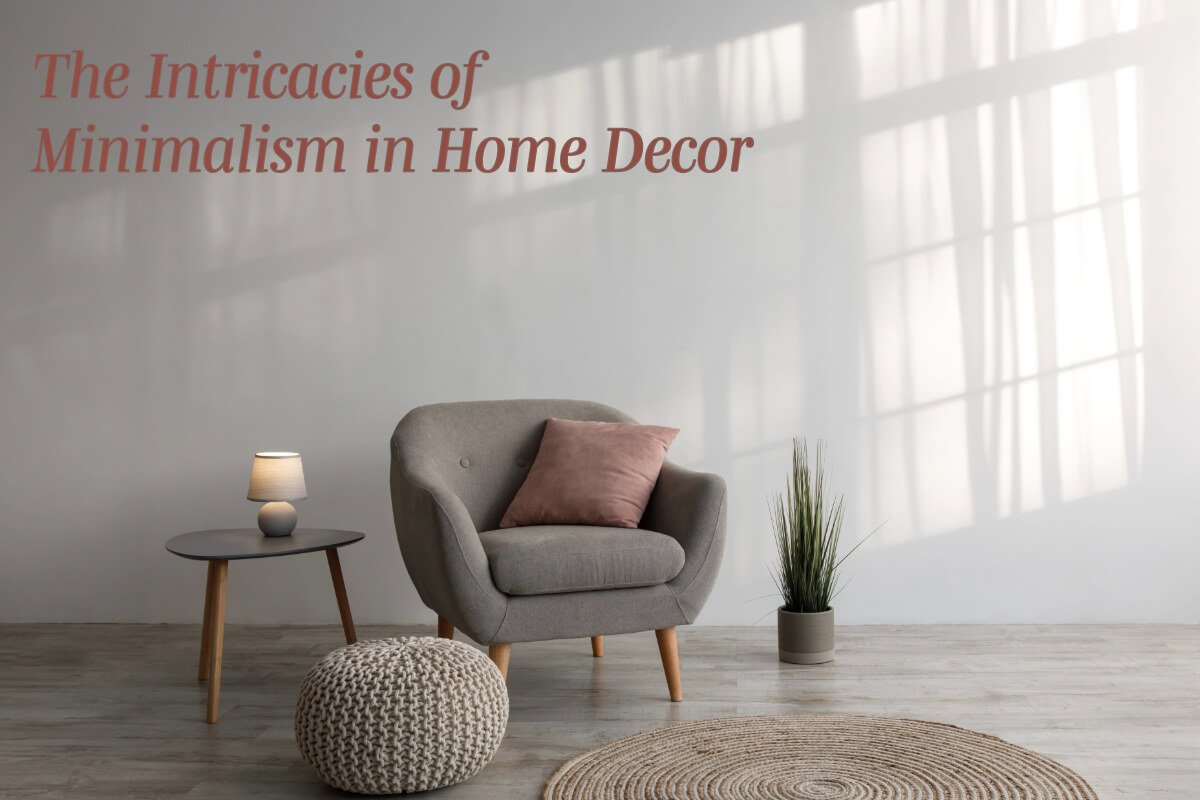Minimalism is more than a popular lifestyle buzzword encouraging us to declutter and live more simply. Its essence permeates various disciplines, including art, architecture, fashion, and home decor.
The minimalist approach in home design can transform a cluttered environment into a serene sanctuary, promoting well-being and aesthetic appeal. But what are the elements that make a home decor genuinely minimalist? Read on as we navigate the nuanced characteristics that breathe life into the minimalist design and its compelling history.
Table of Contents
- A Brief Stroll Through the Timeline of Minimalism
- The Underpinning Principles of Minimalist Design Explored
- The Philosophy of ‘Less is More’ -Minimalist
- Functionality Takes Center Stage – Minimalist
- The Elegance of Clean Lines And Minimalism
- Sculptural Elements as Focal Points Of Minimalism
- Absence of Extraneous Ornamentation and Minimalism
- A Restrained Palette for Cohesion And Minimalism
- A Curated Selection of Materials
- A Place for Everything, and Everything in Its Place
- Mastery of Space and Light
- Exemplary Craftsmanship
- Room to Breathe
- The Antithesis of Minimalism: The Impact of Clutter and Junk on Home Decor
- Related Content
A Brief Stroll Through the Timeline of Minimalism
Before exploring the nuts and bolts of minimalist home decor, a quick tour of its history is beneficial. Born as an antithesis to ornate and overly embellished styles, minimalism has roots in a diverse range of influences—from the geometric abstraction of the De Stijl movement to the austere beauty of Japanese Zen gardens and the practicality of Scandinavian aesthetics.
Groundbreaking designers like Mies Van Der Rohe and Dieter Rams paved the way, making minimalist design a multifaceted phenomenon impacting every design vertical, from skyscrapers to smartphones.
Many may love the minimalist trend for things such as their technology devices such as great-looking computers or smartphones, but may not like their home decor or house design.
The Underpinning Principles of Minimalist Design Explored
The concept of ‘Minimalism’ extends far beyond its trendy reputation as a lifestyle mantra for simplicity and decluttering. It’s a multifaceted philosophy that has influenced diverse fields such as art, architecture, fashion, and, importantly, home decor.
When applied to domestic spaces, minimalism can transform disordered and chaotic environments into peaceful havens, enhancing visual appeal and overall well-being. So, what distinguishes a genuinely minimalist approach to home decor?
Read on as we explore more of the principles of Minimalist design.
The Philosophy of ‘Less is More’ -Minimalist
This iconic phrase, attributed to Mies Van Der Rohe, is the cornerstone of minimalist design. By embracing the “Less is More” ethos, minimalism shifts the focus from quantity to quality, encouraging selecting fewer but more essential items that contribute to a harmonious living space.

Functionality Takes Center Stage – Minimalist
In minimalist design, the function isn’t sacrificed for form; somewhat, it’s enhanced by it. Every item within the home should serve a specific purpose, eliminating the decorative clutter that often distracts from the primary function of a space.
The Elegance of Clean Lines And Minimalism
In minimalist home decor, clean and simple lines are the lifeblood of the design. The absence of ornate detailing contributes to an enduring, timeless quality that eschews transient trends, making it a lasting choice for any home.
Sculptural Elements as Focal Points Of Minimalism
While minimalist design prioritizes simplicity, it’s far from boring. Sculptural forms often serve as the focal points within a minimalist space, seamlessly combining aesthetic appeal with functionality.
Absence of Extraneous Ornamentation and Minimalism
Unlike more traditional or lavish styles, minimalist design does away with gratuitous decorations. The space becomes more focused and serene by eliminating unnecessary elements, allowing for a more tranquil and mindful living experience.
A Restrained Palette for Cohesion And Minimalism
Neutral shades like whites, grays, and blacks dominate the color spectrum in minimalist design. The restrained color palette creates a cohesive look and emotional respite, offering a calming atmosphere.
A Curated Selection of Materials
Minimalist home design often employs concrete, steel, wood, and glass materials. These are chosen not just for their aesthetic qualities but for their functional advantages, often exposed in their natural state to honor their inherent beauty.
A Place for Everything, and Everything in Its Place
Efficient storage solutions are essential in minimalist design, allowing each item to have a specific place. This dedicated approach to the organization helps maintain an environment where peace and order reign.
Mastery of Space and Light
Space and natural light are crucial design elements in a minimalist home. Open layouts and expansive windows optimize these elements, creating an airy, light-filled sanctuary that evolves throughout the day.
Exemplary Craftsmanship
With smaller items occupying the space, the craftsmanship of each becomes crucial. The minimalist home often becomes a gallery where even the most superficial elements are design masterpieces, displaying exceptional craftsmanship.
Room to Breathe
Minimalist interiors typically feature open floor plans and integrated storage solutions. These characteristics contribute to an airy, spacious, and unencumbered living environment, offering an antidote to the chaotic world outside.

The Antithesis of Minimalism: The Impact of Clutter and Junk on Home Decor
While minimalism is often praised for its ability to create serene, functional spaces that enhance well-being, its antithesis—clutter and junk—can have the opposite effect, affecting mental health and aesthetic appeal.
Understanding how clutter contradicts the minimalist ethos can provide insights into why the minimalist approach is so compelling and beneficial.
Clutter as Visual Noise
One of minimalism’s core principles is reducing unnecessary elements to create a calm, focused environment. Clutter, characterized by excess and disorganization, acts as visual noise, detracting from the harmony and balance minimalism aims to achieve.
Where minimalism offers clarity and peace, clutter provides confusion and disarray, making it difficult to appreciate the essential elements in a room.
A Hindrance to Functionality
The minimalist approach prioritizes functionality, insisting that each item within a space should serve a clear, helpful purpose. In contrast, clutter consists of extraneous objects with no specific function or purpose or whose purpose is lost amid the chaos.
This makes it difficult to perform daily tasks efficiently and can lead to a stressful living environment.
Impact on Well-Being
Numerous studies have shown that clutter can hurt mental health, leading to increased stress, anxiety, and even depression. Minimalism seeks to counteract this by creating spaces that promote tranquility and focus.
The philosophy posits that stripping away the non-essential can create room for more meaningful engagement with our environment, thereby enhancing our overall well-being.
Lack of Aesthetic Cohesion
From a design perspective, clutter and junk introduce various colors, textures, and forms that often don’t coalesce into a unified aesthetic.
This starkly contrasts the cohesive, limited color palettes and carefully chosen materials that are hallmarks of minimalist design. In a cluttered space, the lack of visual unity can be jarring, negating any attempts at creating a harmonious atmosphere.
Consuming Space and Light
Minimalism uses space and natural light to create airy, open environments.
On the other hand, clutter consumes valuable space and often obstructs the flow of natural light, making rooms feel cramped and dark. This affects the perception of space and the quality of life for those inhabiting it.
A Cycle of Perpetual Excess
While minimalism advocates for thoughtful consumption and the careful selection of items, clutter often arises from the opposite: impulsive buying, lack of organization, and an unwillingness to part with items, even when they no longer serve a purpose.
This creates a perpetual excess cycle, directly contradicting the minimalist ideal of living with intentionality.
Clutter and junk are not just the physical opposites of minimalism but contradict their underlying philosophy of simplicity, functionality, and intentional living. By understanding how clutter negates minimalism’s benefits, we can better appreciate the transformative power of minimalist design in creating spaces that enhance our aesthetic experience and well-being.

Minimalism in home decor is not a passing trend but a thoughtful design philosophy that prioritizes simplicity, functionality, and beauty. Its enduring principles offer more than just visual satisfaction; they provide a framework for a more mindful, focused, and peaceful lifestyle.
Whether you’re a minimalist fan or a newcomer intrigued by its principles, the impact of this design philosophy is undeniable, continually shaping how we perceive and interact with the spaces we call ‘home.’
Asia Hands pays tribute to the countless skilled artisans across Asia. These individuals pour their heart and soul into crafting some of your home’s most refined home decor products.
Explore our fantastic home decor with cool and unique designs. Click this link to discover various unique products that will spruce up your space. We’ve got something for everyone! Don’t miss out on the simple joy of transforming your home with our stylish collection.
Related Content
Home Decor Vs. Interior Design: What Sets Them Apart
“Home Decor” and “Interior Design” often seem interchangeable when creating a personalized living space. They may seem the same, but they are not.
Home decor and interior design have distinct scope, focus, and approach differences. Understanding these nuances can help you make the most of your home or other interior spaces. If you want to add unique pieces to your decor, Asia Hand offers a curated selection of home accessories.
You can discover more by reading Home Decor Vs. Interior Design: What Sets Them Apart by clicking here.
Home Improvement Vs. Home Decor: Unpacking the Distinctions
Creating your dream home involves many decisions and actions, often falling under two broad categories: home improvement and home decor.
Although home improvement and home decor are sometimes used interchangeably, they serve different functions and come with their own rules and characteristics. Read on as we dissect 15 points of divergence between these two realms while sprinkling in some expert tips for those navigating through either one—or both!
You can learn more by reading Home Improvement Vs. Home Decor: Unpacking the Distinctions by clicking here.

